This is a Yashica Electro 35 GS electronically controlled rangefinder 35mm camera. The Yashica Electro series was launched in 1966 and was the worlds first completely electronically controlled camera. This Japanese camera was very popular throughout the late 60s and 70s, and remains a popular model for collectors due to its extremely sharp lens, accurate meter and shutter, and reliability.
Film Type: 135 (35mm)
Lens: 45mm f/1.7 coated Color Yashinon 6 elements
Focus: 2.6′ to Infinity
Type: Coupled Rangefinder
Shutter: Electronic Copal Leaf
Speeds: B, 30 – 1/500 seconds (Yes, thats 30 seconds)
Exposure Meter: Body Mounted Coupled CdS Light Meter
Battery: Original PX32 5.6v Mercury (No Longer Available), Any 6V Silver Oxide Battery works with this adapter
Manual: http://www.butkus.org/chinon/yashica/yashica_electro_35_gs/yashica_electro_35_gs.htm
History
The Yashica camera company originally started as two separate Japanese companies both who made cameras along with other products.
In 1940, several ex employees of Canon formed the Kōgaku Seiki Company. In 1942, they released their first model, the Nippon, which was a Japanese clone of the popular German Leica camera.
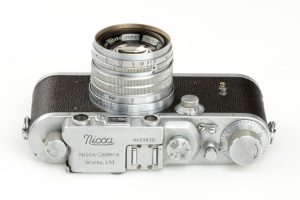
In 1948, Kōgaku Seiki Company changed its name to Nippon Camera Works, and a year later changed it again to Nicca Camera Works. The company continued to build clones of Leica cameras. Although these early Nicca cameras were not very successful, they remain valuable collector’s items today.
Meanwhile in 1949, the Yashima Seiki Company was founded who primarily made electronic parts for clocks. They eventually moved onto camera parts and released their first camera, the Yashimaflex in 1953 which was based off another German camera, the Rolleicord.
Although both the Yashima and Nicca companies made good cameras, after Japan’s defeat in World War II, not many people outside of Japan were interested in a Japanese copy of a German designed camera. Despite their success at making good cameras, both companies struggled to sell their models in large volumes.
In 1958, Yashima acquired the Nicca Camera Works. They combined the resources of both companies and changed their name to Yashica which itself was a combination of both company’s names. Yashica produced several lines of rangefinder and TLR cameras that were well designed and had a reputation as being well made and capable of quality images.
By the 1960s, enough time had passed after WWII that people outside of Japan began to consider Japanese cameras. In the coming years, Yashica would continue to innovate, releasing a line of quality SLR cameras that used the popular M42 screw mount. Their 1966 Yashica TL Super was considered a high point of 1960s SLR cameras and is still popular with camera collectors today.
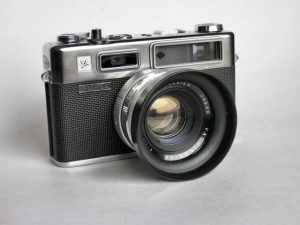
By the mid 60s, Yashica was enjoying quite a bit of success with their TLR and SLR models, but with increased competition from other Japanese camera companies, they wanted to come out with something new that the world had never seen before. In 1966, Yashica would release the all new Electro 35. A large bodied, fully electronic rangefinder camera, the Electro 35 was capable of automatic exposures as fast as 1/500 of a second and as slow as 30 seconds. No other camera at the time could claim such a wide spread of shutter speeds with an automatic exposure mode. Plus, Yashica had also developed a reputation making quality lenses with some of the best optics around. Their Yashinon lenses were second to none in terms of sharpness and image quality.
The Electro was made in several different variants. First was the G in 1968 (G stood for gold plated contacts), then came the GS in 1970 and finally the GSN in 1973. All Yashica Electro GSs had a chrome metal body, but there was also an all black version which was known as the GT and GTN. Production of the Electro ended in 1977, but unsold stock continued to be sold as new through 1980. For whatever reason, there doesn’t seem to be a lot of information out there regarding production information for these cameras. Mine being a GS model, I know mine was made anywhere between 1970 and 1973.
The Yashica Electro 35 was an immediate success and sold over 8 million copies over it’s entire production run. Featuring an aperture priority automatic exposure mode, it was popular with novice and amateur photographers. Starting with the G and all models after, the internal electronic contacts were gold plated to prevent the possibility of oxidation. This decision to switch to gold plated contacts is one of the reasons many Electros are still in good working order today.
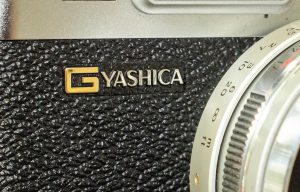
The GSN and GTN had a hot shoe on top of the camera which allowed it to work with modern electronic flashes. For the first time, a family could buy a camera that required no knowledge of shutter speeds, aperture sizes, or exposure setting. The only thing you had to do was focus, and shoot.
Today, if you want a late 60s/early 70s electronic rangefinder camera, a common recommendation is the Canonet QL17 or QL19. The Canonet models were extremely popular when new. They were designed well, were easy to use, and were capable of taking great pictures. The problem with the Canonets is that because they are popular, they demand fairly high prices on the used market. Excellent condition Canonet QL17s can fetch well over $100 on eBay, and although that’s not a high price to pay for a quality camera, I believe the Yashica Electro to be every bit as good of a camera as the Canonet QL17. It is also designed well and it is also capable of taking great pictures. Since its not the “first” choice on many camera collector’s lists, it often sells for much less. I purchased mine on eBay for $25 in good condition.
My Thoughts
The Yashica Electro was my introduction to rangefinder cameras. I had always been aware of rangefinders, but in the digital age, rangefinders are limited to very high end Leicas. When you get into manual focus cameras, most people are familiar with SLRs because they work similarly to modern digital cameras. You look through a viewfinder to focus and compose your shot. SLRs use a mirror and a prism which allow you to see through the lens and compose the image exactly how it will be on film when you release the shutter.
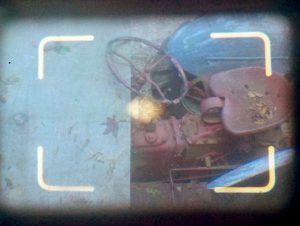
A rangefinder works by superimposing a second, usually much smaller, image on top of the image you see in the main viewfinder. Each of the two images are taken from two different windows on the front of the camera. Using a system of moving mirrors and a special semi-transparent mirror called a beamsplitter, you align both images using the focus wheel on the lens so that they are on top of one another. Since the mirrors move horizontally, it is easiest to align something vertical, such as a pole, tree, or any vertical edge. When both images are aligned perfectly, your focus is perfect. The rangefinder on the Yashica Electro is very large and bright, making this type of focus very easy to do, even in poorly lit conditions. Here is basic demonstration of how a rangefinder works, from the 1980s science show, Mr. Wizard.
My problem is that I have very poor vision. I often have a hard time with manual focus SLRs, especially in low light. Its not as easy to see whether you have sharp focus when using a completely manual SLR. Rangefinders make that a lot easier for me because it is a lot easier to align two images on top of one another rather than “see” focus.
If you’ve never used a rangefinder before, there are a couple of things you need to remember. For one, when you compose your image, you are not seeing exactly what the film will see. This isn’t a problem for shots that are more than a few feet away from you, but when taking pictures of things that are very close, your image can be off by a little bit. Most modern rangefinders have whats called “parallax” correction which means the internal mirrors move slightly when focusing on something close, but it doesn’t get it perfect. This is also important because since you are not seeing through the actual lens, if you forget to take the lens cap off the lens, or if your hand is partially blocking the lens, you won’t see it until you develop your film, so special care must be taken when holding the camera to make sure that the lens is not obstructed.
One of the benefits of rangefinders is that since there is not a mirror flopping around inside of the camera, they are often much quieter. Pretty much everyone knows the distinct sound of a shutter firing on an SLR. With a rangefinder, the sound is a much quieter “click”. You can still hear it fire, but its not as intrusive.
Also, because rangefinders don’t need a large prism to see through the lens, the bodies of rangefinders can be smaller which is appealing to some. The Electro isn’t exactly a small camera, but it is smaller than the typical SLRs of its day.
Finally, one last benefit is that since there is no mirror, you never lose sight of your subject when firing the shutter. With an SLR, firing the shutter requires the mirror to move out of the way of the shutter, which momentarily blocks your view through the viewfinder. This means that you can’t actually see the exact instant the shutter fires. With a rangefinder, this is not an issue and you never lose sight of your shot.
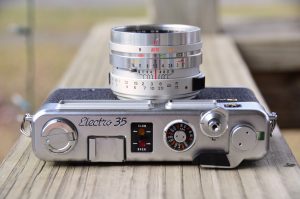 The Yashica Electro has an accurate meter which allows the user to easily find correct exposure. This camera is not capable of full manual mode, but thats OK since the target customer in which this camera was designed for would not have needed a full manual mode. Even the aperture settings are complemented by icons of a sun, cloud, or a house window that indicate shooting in bright sun, in cloud cover, and indoors. You don’t even need to know the aperture number, just turn the lens to whatever icon matches your scene, and the camera does the rest.
The Yashica Electro has an accurate meter which allows the user to easily find correct exposure. This camera is not capable of full manual mode, but thats OK since the target customer in which this camera was designed for would not have needed a full manual mode. Even the aperture settings are complemented by icons of a sun, cloud, or a house window that indicate shooting in bright sun, in cloud cover, and indoors. You don’t even need to know the aperture number, just turn the lens to whatever icon matches your scene, and the camera does the rest.
The Yashica Electro may have been popular with amateur photographers that didn’t want the bulk or the complexity of an SLR, but don’t think that doesn’t mean that its not capable of crazy good pictures, because it is. I’ve read several articles online where people who rediscover this camera are impressed with the pictures it can take. As I mentioned earlier, the Canonet QL17 and 19s are often the first recommendation for people wanting cameras of this age, and I am sure they are very deserving of this praise, but so is the Yashica. Considering how cheap you can find them online, combined with their quality, this could very well be the best bargain you’ll ever find out there.
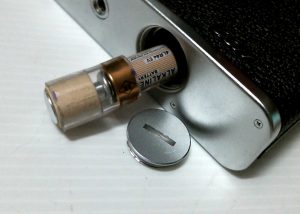
The Electro does have a couple of “gotchas” that a potential buyer should be aware of. For one, it was designed in an era where mercury batteries were the norm for cameras. Mercury has been outlawed in batteries since the late 1990s, so you cannot get the original 5.6v PX32 battery that this camera was designed for. The good news is that there are 6v lithium and alkaline batteries that work fine. The very common PX28 or L544 batteries work fine in the camera with an adapter. This site has a nice chart showing modern alternates for old camera batteries. The original battery was longer than modern 6v batteries so you need something that fills the gap. I found an adapter online for $4 and I bought a battery at Menards. As an added bonus, if the battery ever were to die, the camera is still capable of firing the shutter, but only with a shutter speed of 1/500 sec.
The second thing a potential buyer should be aware of are two common condition issues. The first is that the original foam used to seal out light in the film compartment almost always needs to be replaced. Starting in the late 60s, most camera companies started using a black foam to seal out light. This worked well for the first 20-30 years, but over time, the foam reverts to what can only be called “primordial goo”. Its sticky, messy, and gets everywhere. This is common of all cameras from the era, even the Canonet.
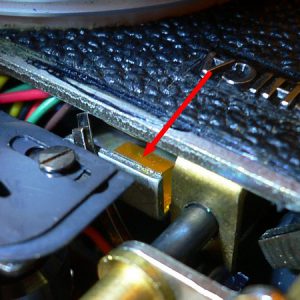
The other condition problem is unique to the Electro. It has earned the nickname “Pad of Death” because of its propensity to die over time. Basically, inside of the camera is a small rubber pad that softens the movement of the film advance lever. Over time this rubber pad can degenerate preventing normal operation of the camera.
You can tell if an Electro has the pad of death problem by listening to it while advancing the film. Even without a battery, after firing the shutter you should hear a noticeable click (or thunk) whenever you advance the film to the next frame. This noise is a good thing. If you do not hear the click while moving the film advance lever, this is bad. There are videos and tutorials online that show you what you should look for and even how to repair it yourself. Yashica Guy’s website is an excellent resource for repairing an Electro.
Don’t let these issues sway you from seeking out an Electro. The previously mentioned Canonet almost always needs its foam light seals replaced and it also has a common issue where the shutter can get stuck due to glue flaking away from where it was originally placed. To fix this, you must disassemble the lens and clean it. Although I’ve never attempted either repair, replacing a small rubber pad seems a lot less difficult than cleaning glue off of shutter blades inside of a lens.
I was lucky enough to get an example that didn’t have the Pad of Death problem. I did replace the light seals using the tutorial I found on Matt’s Classic Cameras. Other than that, mine was in excellent condition. After getting the camera cleaned up, I loaded in my first roll of film and began shooting.
My Results
Since the Yashica Electro has an Automatic exposure mode, using it is incredibly simple. On the top plate of the camera and inside of the viewfinder are two small lights that indicate whether you are over or under exposed. The idea is to select an aperture appropriate for the scene you are shooting and gently press the shutter release button about half way. This activates the camera’s meter and it will measure the light coming through the sensor. If too much light has come in, the “Over” light will illuminate and then you need to compensate by rotating the aperture ring until the light turns off.
The Electro can automatically select a shutter speed as long as 30 seconds, so its unlikely you’d ever find a scene that the camera couldn’t automatically expose for, but there is a point below 1/30th of a second where it is difficult to hold the camera steady without inducing some type of blur into the picture. If the camera detects that a shutter speed slower than 1/30th of a second is to be used, the “Under” light will illuminate. Unlike the “Over” light, the “Under” light doesn’t mean the shot won’t be exposed correctly, it just means that you want to have the camera stabilized on something like a tripod to prevent lens blur. You can still fire the shutter and assuming the camera is held perfectly still, the image will still be correctly exposed.
For casual shooting, you compose your shot and half press the shutter button. If neither light comes on, then you don’t have to worry about any other settings. Just press the shutter release button the rest of the way and you know your shot will come out properly exposed.

 Combine this with the large and bright rangefinder, the Yashica Electro is extremely easy to use, even for someone who has never shot with a manual film camera before. You could literally walk up to a stranger, give them a 20 second demonstration and they’d be able to get some nice shots out of the camera immediately.
Combine this with the large and bright rangefinder, the Yashica Electro is extremely easy to use, even for someone who has never shot with a manual film camera before. You could literally walk up to a stranger, give them a 20 second demonstration and they’d be able to get some nice shots out of the camera immediately.
Take a look at the two pictures above. The second shot is a full size crop of the popcorn kernels showing the sharpness this lens is capable of. This picture was taken outside in an enclosed structure in the shade. I used common Fuji 200 film.
I’ve already shot a couple of rolls of film in my Electro and almost every single shot has come out perfectly. This fact alone is reason to love this camera. As mentioned earlier, the Yashinon lens is very bright and capable of excellent shots. Combined with the extreme ease of use, and the sleek metal body, this camera is definitely a keeper.
| My Final Word | The Yashica Electro lacks some features like full manual control of higher end cameras, but has an excellent lens that rivals the best glass of many other lens makers. Despite these shortcomings, it adds up to more than the sum of it’s parts. The viewfinder is great, the camera feels great in your hands, and it is a lot of fun to use. I have used my Electro more than any other camera I own and I always look forward to using it. I believe that you could hand this camera to someone who has never shot a film camera before, give them a 30 second tutorial, and they’d be able to shoot the whole roll perfectly. Get a GSN for the best chance at a good Pad of Death, and make sure you get the correct battery adapter, but once you do that, I challenge anyone to not find something to love about this camera. | ||||||
| Images | Handling | Features | Viewfinder | Feel & Beauty | History | Age | |
| 2 | 1 | 1 | 2 | 1 | 1 | 20% | |
| Bonus | +1 because of the indescribable cool factor. I really like the Yashica Electro, I enjoy shooting with it, its got a great lens, and I always get good results with it. Even if the Electro isn’t great on paper, there is something special that draws me back to mine more so than most other cameras I own. | ||||||
| Final Score | 10.6 | ||||||
Additional Resources
http://en.wikipedia.org/wiki/Yashica_Electro_35
http://www.photoethnography.com/ClassicCameras/index-frameset.html?YashicaElectro35GSN.html~mainFrame
http://mattsclassiccameras.com/yashica_gsn.html
http://www.yashica-guy.com/index.html
http://www.kenrockwell.com/yashica/electro-35.htm
http://camerapedia.wikia.com/wiki/Yashica_Electro_35
https://www.flickr.com/groups/yashicaelectro/
http://www.shootwithpersonality.com/2013/08/24/my-favorite-faves-yashica-electro-35-gsngt/

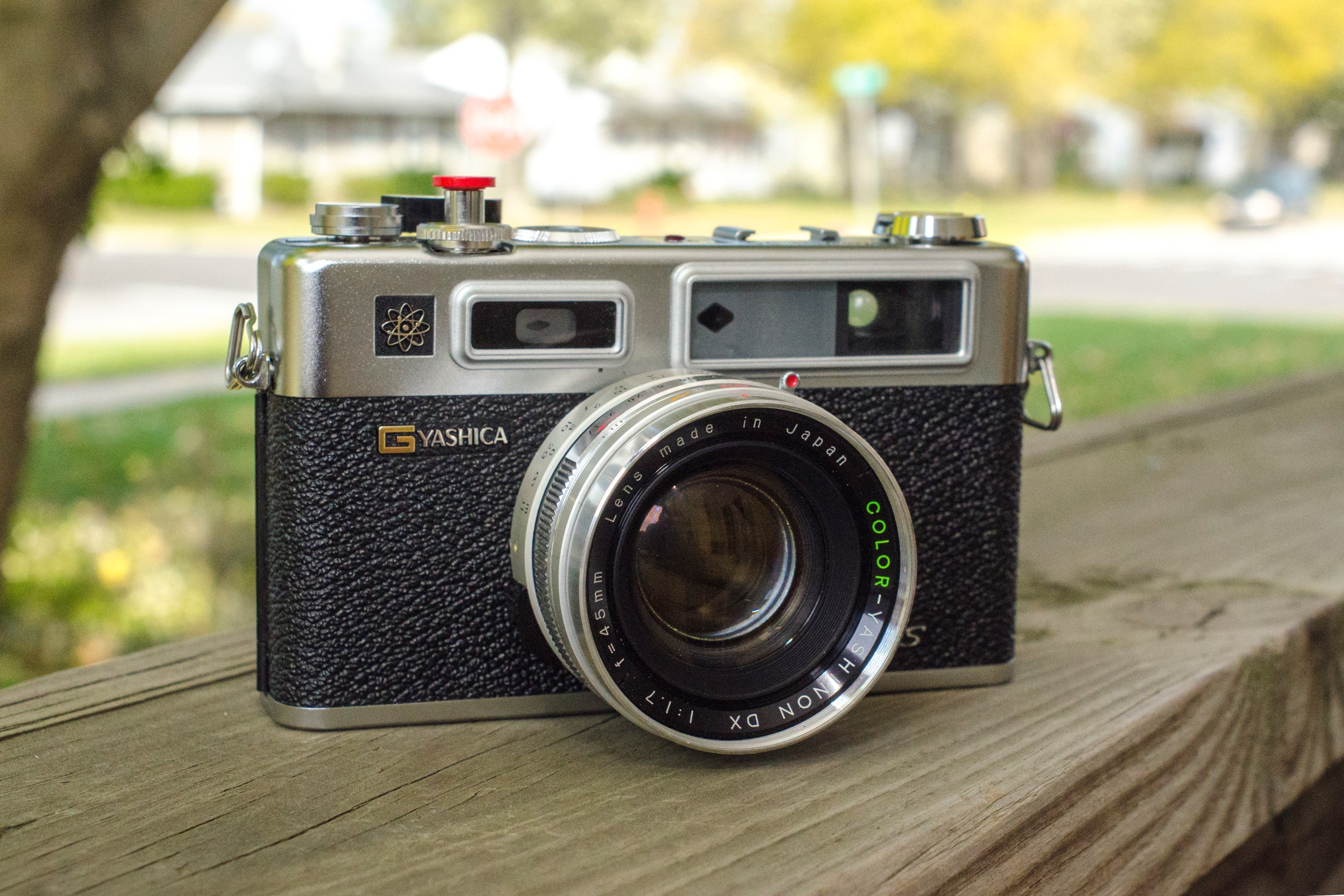
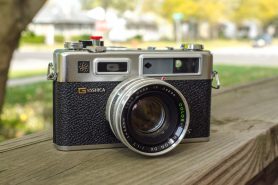
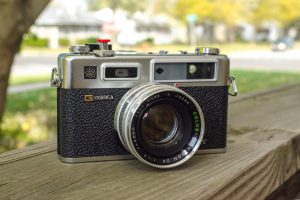












For someone with vision issues you certainly take magnificent photos! Kudos!
Thanks Andrew! I am completely blind in one eye and have a -9.0 prescription in my left. What little I can see, I try to put to good use through photography! 🙂
Another great review Mike. Your blog is very well done!
You might want to check out my friend Paul’s site at http://www.yashicatlr.com to get a better handle on the beginning days of Yashima.
Do you think that it can be used without battery, doyou know at what speed it shot if withou batteries? Thanx
Yes, you can still use the Electro without a battery. The shutter will only fire at 1/500 though, but as long as you can account for that with the aperture, it can still be used.
Your photo of the switch-coupling pad/Pad Of Death is BY FAR the best on the internet. I’m dealing with mine (it’s bad, of course) and this is the only photo of one that is in position and in good shape. Given the location, that’s amazing. Thanks!